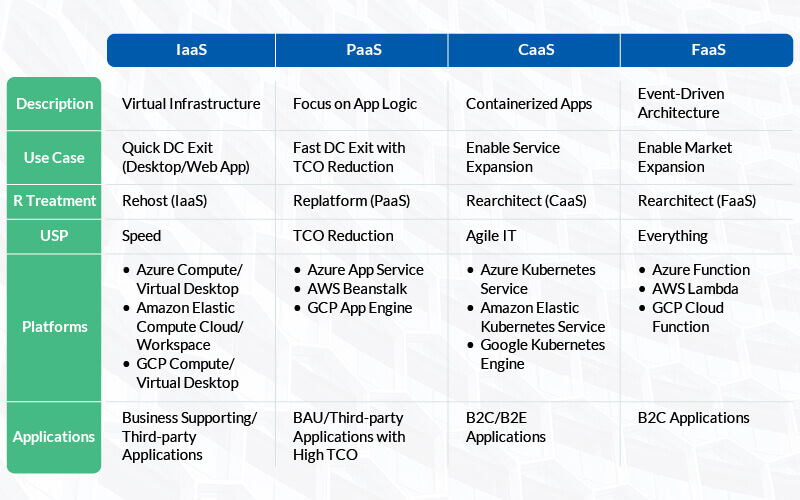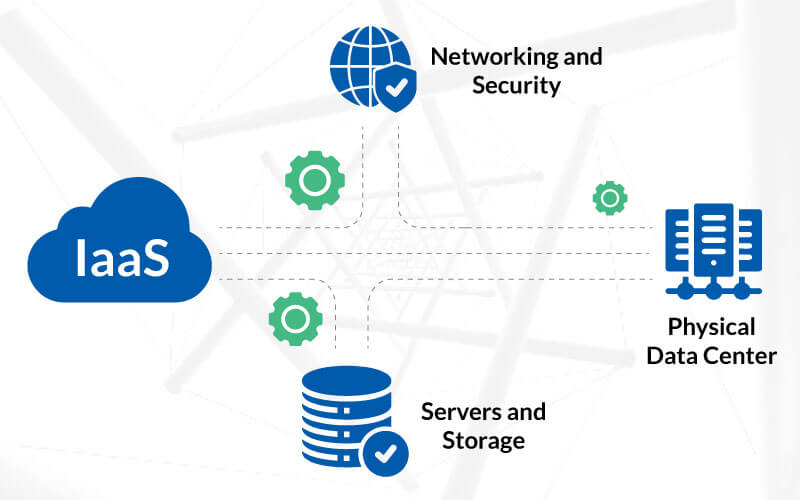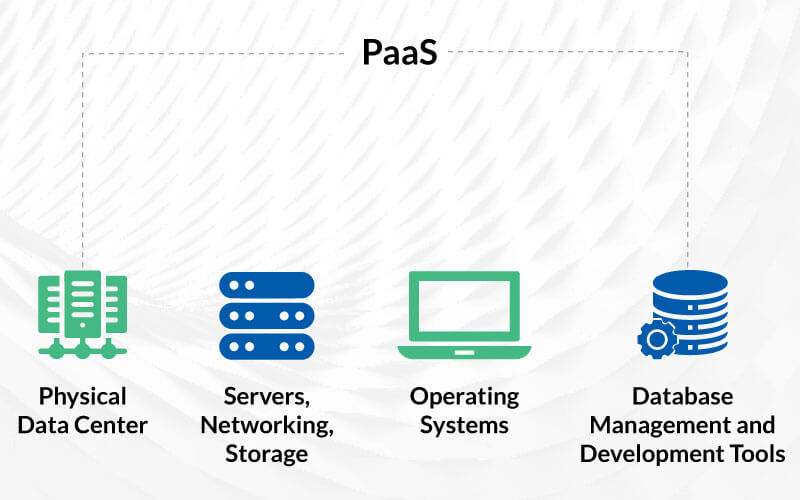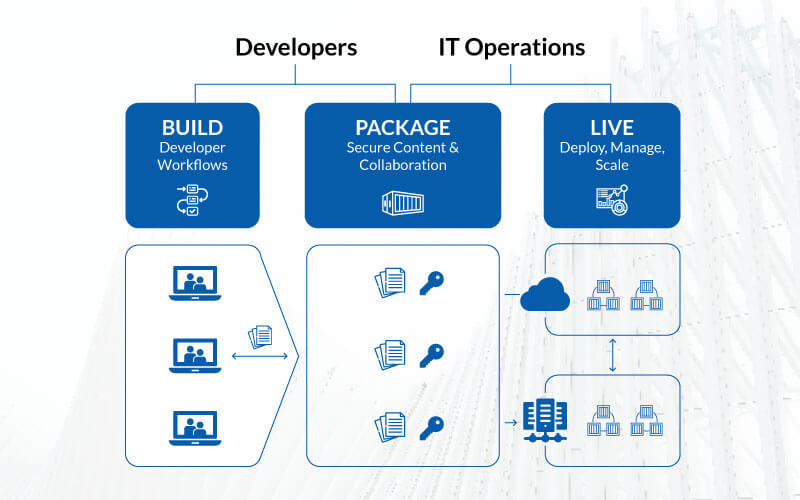Introduction
Organizations are reinventing themselves and moving to cloud-based architectures for greater scalability, improved resource utilization and increased collaboration. Over the past few years, one of the biggest trends in the IT Industry is the “as a service” model, also known as “XaaS”.
In the XaaS model, organizations provision their services and applications on cloud based architecture, rather than physical infrastructure. There are multiple XaaS models, Infrastructure as a Service (IaaS), Platform as a Service (PaaS), Container as a Service (CaaS), and Function as a Service (FaaS). Given multiple XaaS models, it becomes difficult to keep track of all the offerings, differentiate between them, and identify the most suitable one that fits the organization’s needs.
Amaze® is a one-of-a-kind solution that performs thorough assessments and helps organizations identify the most suitable cloud migration model. Amaze® performs a 100% automated Application Readiness Assessment to discover the readiness of on-premises custom web/desktop/COTS applications to migrate to any
open-standard public/private cloud PaaS/CaaS/FaaS using Replatform, Refactor, Rearchitect, and/or Rewrite based on user cloud design decisions and architectural choices.
Post assessment, amaze® can enable a virtualized pay-as-you-go IaaS model and transform portfolio applications from closed enterprise architectures to an open-standard cloud PaaS, CaaS, and FaaS on any public cloud that supports open-standard enterprise architecture like Google, AWS and Azure.
The following table illustrates various “as-a-Service” platforms and how amaze® relates its offerings with the platforms. As we move from laaS to FaaS, the agility increases and control over infrastructure decreases.

IaaS
Although IaaS closely resembles owning a data center, the difference between IaaS and a data center is that there is no need to buy any physical infrastructure and servers can be located in various parts of the world. IaaS provides an option to rent actual hardware such as servers, storage, and networks or get virtual machines that behave just like them. In the IaaS model, managing and provisioning hardware and installing applications is the responsibility of the organization’s IT professionals.

a. When to choose IaaS?
- When there is a need to switch from owning a private data center to renting infrastructure from a major cloud service provider
- When there are highly configurable solutions that require granular control over servers, storage, and networking services
- When a dedicated IT professional is available to configure, manage and monitor the platform components
- When control over applications is a greater priority than cost savings
b. Migrate to IaaS with Amaze®
Amaze® for Applications provides a quick cloud migration approach to operating workloads on VMs. Amaze® migrates applications and data center components to the cloud by VM-to-VM migration. IaaS migration is supported for:
- Desktop applications
- Virtual desktop
- Legacy applications
- COTS applications
PaaS
In the Platform as a Service (PaaS) cloud model, the infrastructure, operating system, and development tools are provided by the Cloud Service Providers. PaaS takes advantage of all the virtualized resources from IaaS and abstracts them. The user doesn’t have to worry about managing those VMs. A PaaS platform releases application developers from the burden of building, configuring, provisioning, and managing infrastructure resources. Since all other resources are in place, developers are only responsible for managing the application and data.
PaaS can impose less overhead and be more cost-effective than IaaS, but it is more complex and
time-consuming than IaaS.

a. When to choose PaaS?
- When there is a need to migrate custom applications, middleware, and database platforms to the cloud
- When there is a need to transition from on-premises server licenses to cloud pay-per-use licenses
- When cost reduction is a greater priority than control over applications
- When developers benefit from rapid development and automation is a greater priority than granular control over infrastructure
b. Migrate to PaaS with Amaze®
Amaze® for Applications provides automation-based replatforming to PaaS solutions for publishing, updating, and scaling applications to cloud without worrying about the underlying hardware. Amaze® helps gain more control with a PaaS offering, like assessing respective dependencies, specifying the number of instances to run applications and setting a limit on the amount of memory each of the instances consumes.
Amaze® enables a quicker time to market by automating the migration of application, middleware, and database platforms to cloud by 60-70%.
Amaze® enables the transition from on-premises licenses to cloud pay-per-use licenses and reduces TCO
by 50-60%.
CaaS
In a Container as a Service (CaaS) model, users can package applications and their libraries and dependencies into lightweight containers and deploy them on the cloud. CaaS solutions take advantage of all the virtualized resources from IaaS and additionally provide the container engine and orchestration. Since containers are lightweight, a single host can accommodate more containers than full-scale VMs. CaaS allows developers to have more control over virtualization, operating system configuration, and containerization tasks.

a. When to choose CaaS?
- When more granular control over container orchestration is a priority
- When greater control is required than PaaS in terms of language support or multi-cloud hosting
- When there is a need to enable application scalability for known user loads, independent of each other
- When performance, uptime, and scalability are required to ensure reliability in mission-critical applications
b. Migrate to cloud native CaaS with Amaze®
Amaze® for Applications provides automated Rearchitect to CaaS solutions by modifying the application’s codebase to optimize it for the cloud CaaS platform. Amaze® enables developers to decouple custom application’s user interface, services, and database layers then transform to independent microservices in an organized and easily manageable environment. Amaze® supports 12-factor principles and enables application containerization and scalability with known user load (as per the business requirement), independent of each other. Amaze® reduces technical debt up to 50% and costs up to 70%.
FaaS
Function as a Service (FaaS) is a function-based model that can be triggered by events. FaaS is also referred to as serverless architecture since the user doesn’t need to manage or provision servers. The developer just needs to focus on writing the functions and not worry about deployment, load balancing, or scalability, as the allocation of resources is managed by the platform. FaaS allows users to pay only for the actual consumption of compute and storage, not on the resources declared.

a) When to choose FaaS?
- When the priority is writing functions rather than managing infrastructure
- When the user load is unknown and there is no upfront provisioning
- When the business requires an on-demand auto-scalable solution
- When workloads are event-driven and short-lived
b) Migrate to cloud native FaaS with Amaze®
Amaze® for Applications is on par with “fully managed” cloud migration solution and it alters existing application services in accordance with the cloud FaaS Platform. FaaS with amaze® abstracts complex server management from developers and allows them to focus on writing functions and execute them in response to events. Amaze® leverages up to 70% automation to enable scalability with unknown user loads (as per the business requirement) independent of each other. FaaS with amaze® provides higher ROI since it is pay-per-use, instead of fixed operating cost.
Still unsure which is right for you?
Take amaze®’s 100% Automated Application Cloud Transformation Readiness Assessment to identify the right choice between IaaS, CaaS, PaaS, and FaaS. The decision of which model to select can be made by considering the assessment report that shares the most suitable model and the granularity of control required over IT Infrastructure:
IaaS: Ideal if the user needs greater control over IT Infrastructure but also scalability and cost-benefit of the cloud
PaaS: Best choice if the focus is on building applications rather than dealing with the complexity of setting up IT infrastructure (i.e., servers, networks, and databases)
CaaS: Suitable when developers need the convenience of container-based virtualization along with PaaS benefits
FaaS: Ideal for high-volume workloads that are event-driven and short-lived and need rapid scalability
Start your enterprise cloud transformation journey on an automation-led platform by partnering with Hexaware’s US Patented IP amaze® for a simplified and cost-efficient migration. Reach out to amaze@hexaware.com and check out our amaze® product suite to take advantage of agile-based deployment, greater scalability, and improved resource utilization.



















